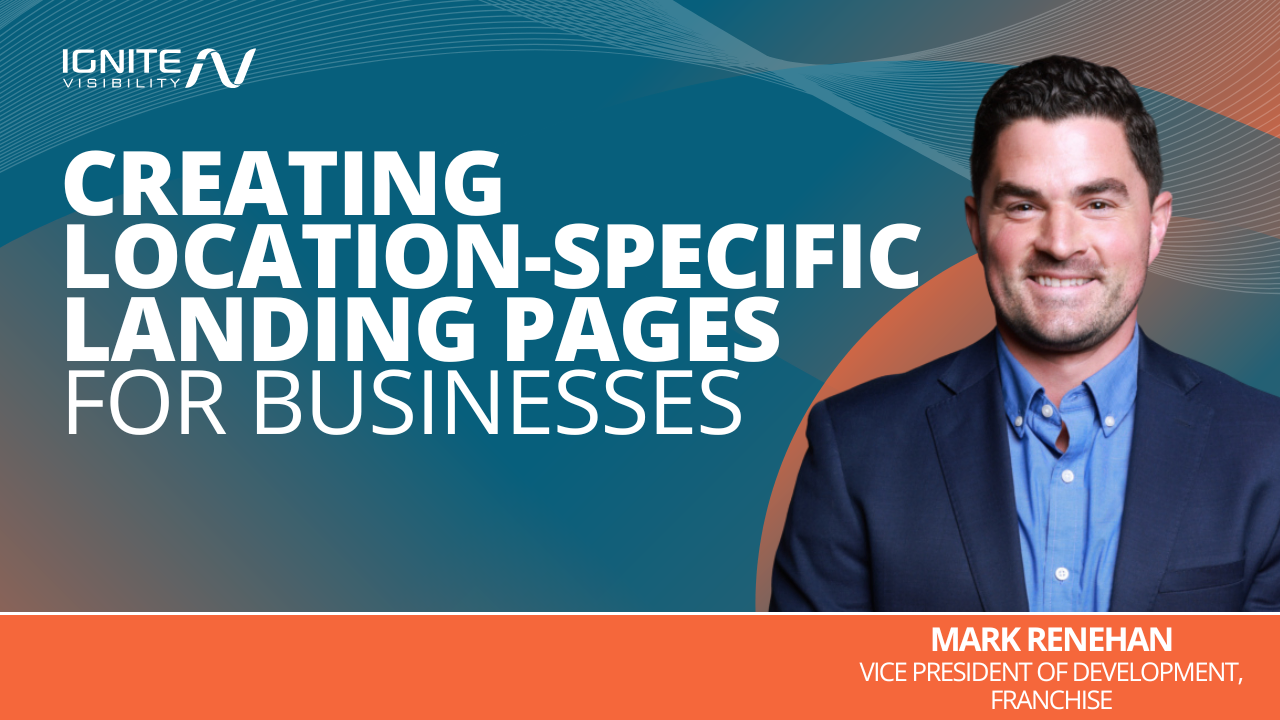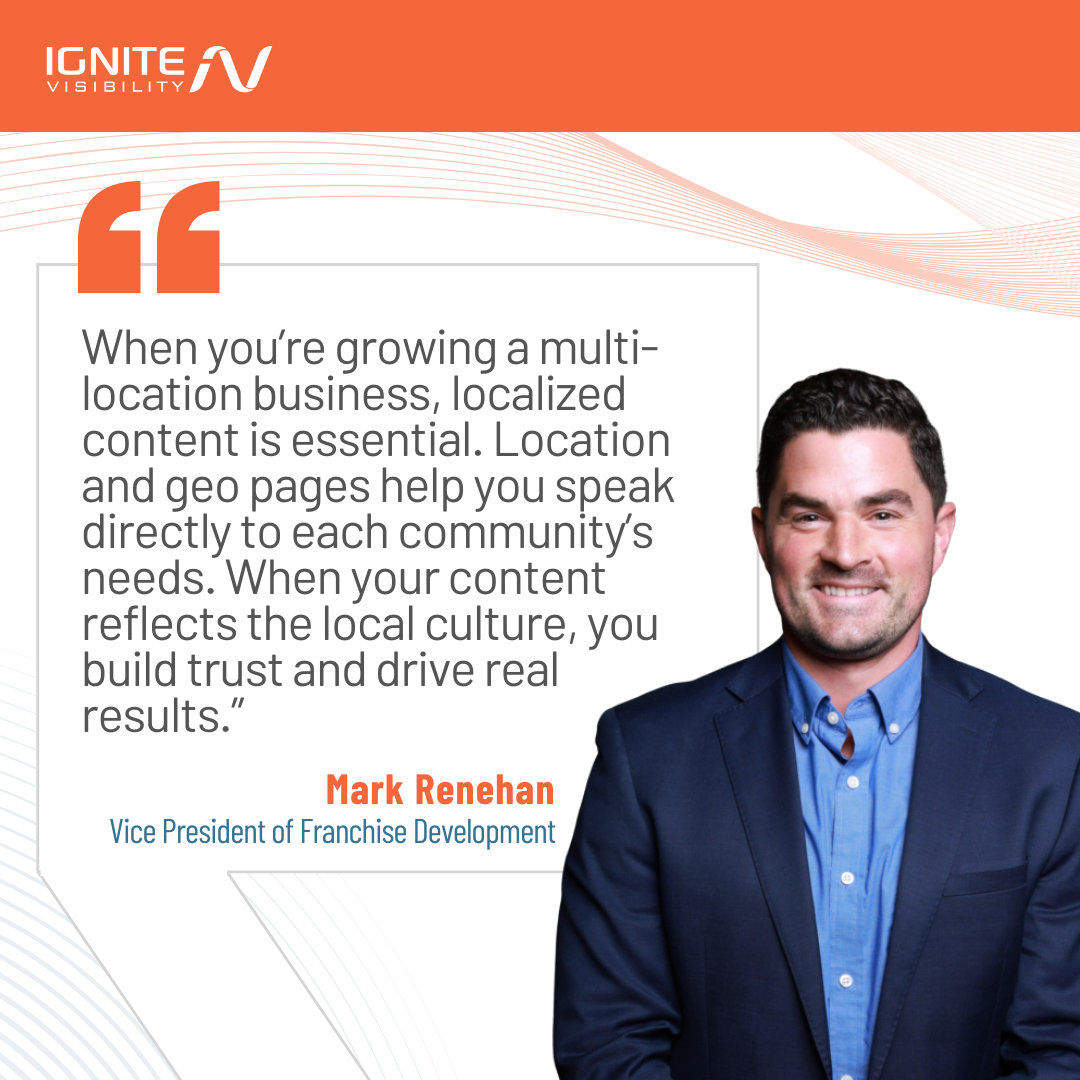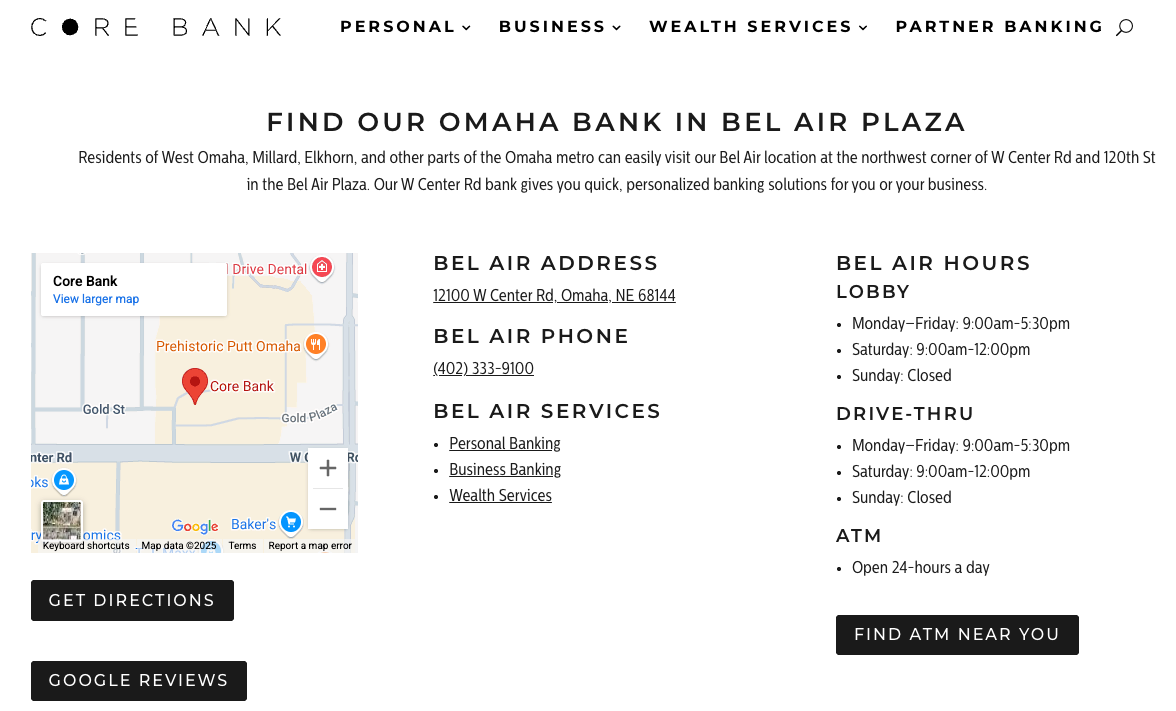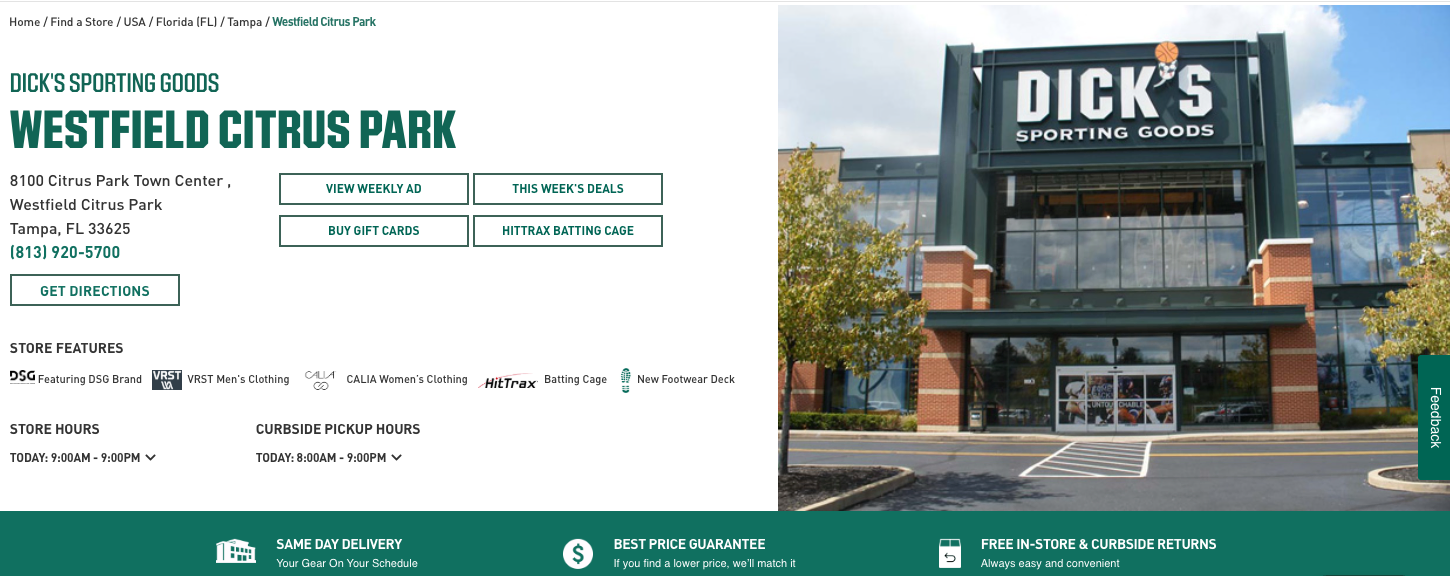
Running a multiple-location business means you have to do things a bit differently.
You must target the right people at the right time with your content, appealing to each local audience’s needs and wants. Whether creating location pages for specific areas or developing broader geo pages on a national or international level, it’s important to take into consideration everything from the latest algorithm updates to mobile-first indexing.
Geo pages are critical for local SEO, indicating how to rank a service area business with a solid foundation.
In this blog, VP of Development, Franchise, Mark Renehan, will explain what a location page is and how you can use it to boost your business’s organic traffic.
What You’ll Learn:
- What Are Location Pages?
- When Are the Best Times to Create Location Pages?
- Why are Location Landing Pages Essential for SEO?
- How to Create SEO-Friendly Location Pages
- Leveraging Geo-Analytics for Location Page Optimization
- Examples of Noteworthy Location Pages
- FAQs About Location Pages
My Expert Opinion on Creating Location-Specific Landing Pages
When growing a national-to-local business with multiple locations, you need a combination of location pages and geo pages. While location landing pages target more specific geographical regions, a geo page covers a broader area, e.g., location pages could cover certain towns and cities, while geo pages might cover a region, state, or even an entire country.
When creating location-specific landing pages for your locations and service areas, they must speak to the differences in each location. Certain regions and cities will have unique cultures and communities that impact how you connect with potential customers and franchisees.
You must also incorporate multiple marketing tactics to boost your location landing pages’ visibility on search engines and bring more web and foot traffic to your business. By taking the right approach to location pages SEO and other marketing elements, you can ensure your pages establish a strong relationship with all prospects.
When integrating these pages into a holistic marketing program, you could significantly boost engagement and overall business performance. According to a recent Annual Franchise Development Report from Franchise Update Magazine, one quick-service restaurant was able to develop a site that saw a 7.87% conversion rate, largely thanks to SEO-focused content, including locally targeted pages. Additionally, 53% of survey respondents found targeted, custom direct marketing to potential franchisees to be the most successful recruitment method.
Now, let’s get into how to create city pages for service area businesses and explore some location page examples.

What Are Location Pages?
Location pages, also sometimes referred to as geo pages (though we’ve discussed the nuances above), are individual landing pages customized to each of your individual locations. They provide information specific to that location, such as contact information, address, local landmarks, and more.
For example, if you own multiple David’s Bridal locations but only have one general website, you might capture the search results from “David’s Bridal” but not necessarily from all the searches specific to your individualized cities.
With the help of location pages, each of your locations would have its landing page. So, when users search “bridal store Houston” or “David’s Bridal near me” from Sugarland, Texas, your Houston or Sugarland-specific geo pages will pop up.

If you want to capture all of the organic traffic you can, optimizing your site for those searches is important. With “near me” searches specifically growing in popularity, geo pages are going to become even more valuable.

There are multiple benefits of using location and geo pages, as they can improve local search rankings when people look for businesses in your industry near them, drive more targeted traffic that’s likely to convert, and generally boost user engagement.
However, to determine how well your location pages SEO and other marketing efforts are performing, you will need to measure your campaigns with metrics based on your goals, such as:
- Increased local search visibility based on page views, traffic, and keyword rankings
- Increased conversion rates from localized content, whether that conversion entails completing a lead capture form or making a purchase
When Are the Best Times to Create Location Pages?
Just like any other part of your digital marketing strategies, certain times of the day are better than others to create your new geo pages. Here are some of the best times to think about creating or updating your franchise landing pages.
During a Franchise Launch
One of the best times to create a geo page is when you’re able to launch a new franchise location. Tailor this page to the specific location, sharing important location-specific information such as hours, address, phone number, etc.
Prior to Expanding to New Locations
If your franchise is in a growth phase and planning to open new locations, give yourself enough time to create a geo page for each location. Starting well in advance will allow time for SEO optimization and ensure that each page is ready to go as soon as the new location opens its doors.
Seasonal or Local Events
Geo pages can also be created ahead of local events, holidays, or seasonal promotions. This will prime your audience and ensure that your franchise is well-prepared to target them during these special events.

When Targeting Specific Demographics
If your franchise wants to target specific demographics in different locations, consider creating geo pages as part of your marketing strategy. Tailor the content and messaging to each specific demographic.

As Part of an Ongoing Marketing Strategy
Geo pages are not a one-time effort. They are part of your regular marketing strategy. Just as you would make time to update your social media or general website content, you should regularly update and optimize your franchise landing pages.
When Expanding Online Presence
If your franchise is looking to enhance its online presence or local search visibility, geo targeted landing pages can play a significant role. Make sure they’re a part of your digital expansion strategy.

When You Have Unique Local Content
If you have valuable and unique local content to offer, such as local stories, customer testimonials, or partnerships with local businesses, create geo pages to showcase this content.
When Conducting Local SEO Audits
Periodically conduct local SEO audits to identify areas for improvement. If you find gaps in your local SEO strategy, create geo pages to address those gaps and enhance your local search rankings.
In Response to Competitor Action
If your competitors are actively targeting specific local markets, consider creating geo pages to maintain a competitive advantage. Not doing this is the same as handing over your audience directly to your competitors.
Why Are Location Landing Pages Essential for SEO
There aren’t many things more important than landing pages for SEO. When they are created and optimized correctly, they can lead to improved local search visibility, enhanced user experience, increased customer engagement, and overall improved rankings.
SEO Techniques to Use on Location Pages
If you want to reap the SEO benefits, it’s important to optimize your content correctly. Spend time incorporating techniques such as embracing local keywords, optimizing headings (including H1, H2, and H3 headings), and meta descriptions.
The more customized information you add about your location, the better. Not only will it help to capture that local traffic, but it will also improve your customer experience. Include details such as hours of operation, photos of the interior and exterior of the building, specials, promotions, and reviews of each location.
Providing the most up-to-date and location-specific information also benefits your audience because they will never be left in the dark about anything. They might even see a post or picture that inspires them to visit the location closest to them.
Geo-Analytics for Franchise Locations
Since you’ll be investing time and energy into developing these new pages, you’ll probably want to see your ROI. To do this, use geo-analytics to track your pages’ performance across all locations. Not only will this show you that your techniques are working, but it will also give you valuable insights into each location’s strengths and weaknesses.
Embrace tools such as Google Analytics, heat maps, and geographical A/B testing to provide insight into how you can improve your localized marketing strategies.
How to Create SEO-Friendly Location Pages
Creating an effective franchise marketing strategy begins with your landing pages. Here are the top 7 things that you should include in your geo page.
1. Conduct Keyword Optimization
Do keyword research to find the best local keywords to incorporate into your geo pages. Consider things like city names, neighborhood terms, and “near me” phrases.
2. Add On-Page SEO Elements
Incorporate on-page elements like optimizing title tags, meta descriptions, headings, and URL structures.”
For things like title tags, headings, and meta descriptions, be sure to include the service or product and the location of your business. For example, if we were writing a title tag for the BBQ restaurant, we would write something like “BBQ Restaurant in San Diego, California.”
You should also interlink your geo pages. For example, if you have restaurants in San Diego, Carlsbad, and Riverside, make sure you link them all on your individual franchise landing pages. This will interlink your pages together and give you even more of a chance of showing up for those coveted “BBQ restaurant near me” searches.
3. Create Location-Specific Content
The next step to a fantastic geo page is to get specific! Don’t have the same general content on every page. That’s the best way to get dinged by Google for duplicate content.
Instead, craft copy that provides accurate information that is relevant to each specific location. Include information such as your location’s address, local landmarks, cities, and other location-specific information.

4. Unique Location Page Design
Don’t get so wrapped up in your local-specific content that you forget about the design!
The best location page designs are built with the user in mind. Embrace concepts like an intuitive design, maps, contact information, and clear call-to-action buttons.
5. Lean on User-Generated Content
You can write the most compelling copy in the entire world, but sometimes, your audience is going to want to hear from other customers!
Prominently display user-generated content like reviews and testimonials on your geo page.
6. Include Visuals and Local Imagery
Enhance your user experience and engage visitors by providing local images, videos, and maps. This will give them a better feel of what it’s like to visit your location.
7. Add Your Google Maps Physical Location
If you haven’t updated your physical location in Google Maps, consider this a sign to do so now! We don’t necessarily mean you have to embed Google Maps into your geo-targeted landing pages (although that IS an option!). At the very least, make sure that your contact information is exactly the same on both the map and your geo page.
However, it’s often helpful to potential customers if you include a Google Map on city pages, eliminating an extra step from finding you online.

8. Call-to-Action Placement
Like any other type of landing page, your call-to-action button placement is critical. Make sure you tell your visitors exactly what to do next using language such as “schedule your appointment now!” “call us today!” or “visit us here!”
Place these buttons in highly trafficked areas of your page and use bright, attractive colors so your visitors won’t miss them.
9. Optimize Forms and Conversion Elements
If your intended conversion relies on forms or other lead-capturing elements, they should be properly embedded and positioned on your landing page. To encourage more people to complete the conversion, make them as easy as possible to see and follow through.
10. Track Conversions
Use analytic tools and software to measure lead generations, form completions, and other conversions on your location pages. Analyze this data regularly to see where you can improve your page based on your user behavior data.
11. Ensure Your Pages Are Mobile-Friendly
When creating location-specific landing pages, you must also ensure they’re mobile-friendly for smartphone and tablet users. The fact is that the majority of all website traffic (62.76%) comes from mobile devices, especially on the local level as people look for places “near me.”
12. Continually Improve the Localized User Experience
Make sure the user experience appeals to local visitors. Indicate that you understand what people want and need in each location, potentially demonstrating knowledge of the local geography and culture. The more people feel like your location pages speak to them, the more your content will resonate and move people down the funnel.
13. Use Structured Data
Structured data is another critical element to consider as you discover how to create city pages for service area businesses. This technical SEO element describes what kind of content your page is about, which helps search engines understand it better. The end result is potentially better rankings.
Leveraging Geo-Analytics for Location Page Optimization
We touched on the idea of geo-analytics briefly above, but let’s dive a little bit deeper.
So, what are geo-analytics in the first place? Geo-analytics is the process of gathering, analyzing, and interpreting geographical or location-specific data. Since each market will vary, those with multiple locations will need to tweak their marketing campaigns and content based on that specific location’s interests. That’s where geo-analytics comes into play.
After you publish your location pages, monitor their progress and use that data to refine your content. Even seemingly little changes like the placement of your CTA buttons or the page design could either encourage more visitors or hinder traction on each site.
Use the data you gather to optimize your content and target underperforming areas for each location.
Also, be sure to incorporate local imagery, customer reviews, and community-specific information. Taking this step will give each location landing page a more human touch and show that you know your market.
To build more trust and engagement among your audiences, it’s also important to add some interactive elements to each location and geo page when possible.

Strategies for Ranking a Service Area Business
If you want to know how to rank a service area business the right way, here are some effective strategies to implement:
Local SEO Best Practices
One aspect to consider is optimization for local SEO through your location pages and citations.
Some specific strategies to use here include:
- Improving Local Citations: Make sure local citations on platforms like Google Business Profile are accurate and up-to-date with the latest information. Keeping all of these details aligned will help your SEO, while local images and other content will help you connect with local users. You can also use tools like BrightLocal to effectively grow and manage all of your business citations for better SEO.
- Obtaining Quality Backlinks from Local Sources: Try to get links to your website from local industry blogs and magazines through guest posts and articles, which will help with your off-page SEO efforts as you discover how to rank a service area business.
- Managing Online Reviews: Encourage your customers to leave a review on Google, Yelp, or another platform. While you can’t get rid of honest bad reviews, you can take the opportunity to address any issues with a thoughtful reply, which could make you look better to other potential customers. Be sure to highlight positive reviews on your pages.
Competitive Analysis and Local Content
When determining how to create city pages for service area businesses, look at competitors and see what they’re doing (and not doing). Using tools like Semrush, you can take a look at competitors’ rankings and look for potential content gaps that could inform your strategy.
In doing so, look at other local content. Maybe you’ll find that there’s a certain lack of personalization or that your competitors are overlooking a major aspect of the local community.
Based on your competitor analysis, you’ll ultimately find ways to stand out when creating location-specific landing pages.
Conversion Optimization
As you work on conversion rate optimization, develop high-quality calls-to-action for each page that keep people moving along the customer journey.
Here are a few tips to help out:
- Keep your CTAs clear. Incorporate a direct action that moves people through, like “Find Your Nearest Location and Get Access to Exclusive Offers!”
- Optimize for local content. When appropriate, you can also include location-specific keywords on a location or geo page.
- Create a sense of urgency and exclusivity. If you have exclusive local promotions or limited-time offers, be sure to include them in your CTAs.
- Make CTAs highly visible and mobile-friendly. Any buttons you add to your location pages should be clear and make it easy for both desktop and mobile users to convert.
Monitoring and Adjustment
Creating location-specific landing pages is only the first step. Once you’ve published them, you must continually monitor them to gauge performance and make any necessary adjustments.
Tracking tools like Google Analytics 4 (GA4) can help you measure each page’s performance. The metrics you track should correspond to your specific goals, whether you want to drive more traffic and page views or boost engagement or conversion rates.
As such, the metrics you track could include page views, time on page, organic traffic, conversion rates, and click-through rates, among others.
If you find any issues with underperforming pages, make the necessary changes to get them in better shape. As you determine how to create city pages for service area businesses and optimize location pages SEO, you can conduct A/B testing, running two versions of a page with one element changed out.
Based on which page performs the best, you could then figure out what’s working and what’s not, incorporating it into all future pages.
Examples of Noteworthy Location Pages
U.S. Lawns
Although headquartered in Orlando, Florida, U.S. Lawns has a specific location page for each of its individual locations.
After clicking on the appropriate location near you, it’ll pull up a completely optimized location page specific to that market.

This Tulsa-specific location page speaks directly to residents of Tulsa, Oklahoma. It names local communities and gives local contact information. Further down on the page, it names the local owner and provides reviews of the Tulsa North location instead of the overall U.S. Lawns national franchise. This gives their Tulsa visitors peace of mind that this specific location will do a great job.
Dunkin’
American runs on Dunkin’, right? They have a featured homepage for all nationwide Dunkin’s but also break them down into location-specific ones.

The location page features that specific location’s hours, features, map, and more.

Jimmy John’s
Jimmy John’s is another franchise with one of the best location page examples.
Here is the general company page:
Here is an example of a location-specific page:
Their location page provides the address, phone number, hours, and other location-specific information, including menu and availability of options.
Batteries Plus+
Batteries Plus+ is another awesome example of a franchise with solid location pages. Here is their nationwide home page:
But they also give you options to select the store closest to you to see all of that store’s location-specific information and in-stock items.
FAQs About Location Pages
1. What is a location page?
A location page is a landing page specifically designed for a local market. It includes localized information such as address, phone number, hours of operation, and more.
2. Do location pages work for SEO?
Yes! SEO and location pages go hand-in-hand. When you optimize a landing page for each specific franchise or location of your business, you’ll be able to capture traffic for local and “near me” searches better than if you just have one giant webpage for all of your locations.
3. How can I write a location page for my multi-location business?
The most important thing to remember is that your content should be tailored specifically for each individual market. Include basic information, such as address, phone number, brand name, and hours. Also include a map, local pictures and information, special local deals, and other customized information.
Get More Attention With Your Geo Pages With Ignite Visibility
Whether you’re looking to increase your local SERP ranking, enhance user experience, or encourage more engagement, Ignite Visibility can make it happen.
We have created geo pages for businesses all over the country in almost every industry, including construction, home remodelling and repair, dental, medical, real estate, and more.
Ignite Visibility can help you:
- Build out franchise landing pages
- Optimize your conversion rates
- Create a cohesive local SEO strategy for your website
- And more!
Are you ready to see why so many of our clients are top-ranked within their service area? Reach out today!






